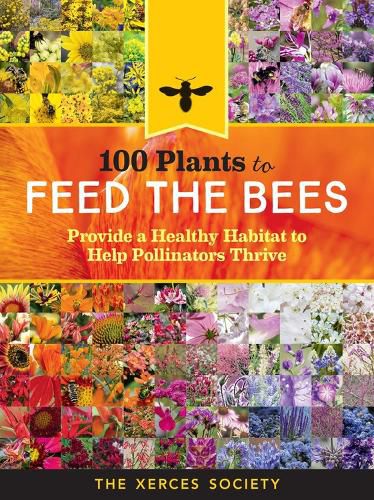Readings Newsletter
Become a Readings Member to make your shopping experience even easier.
Sign in or sign up for free!
You’re not far away from qualifying for FREE standard shipping within Australia
You’ve qualified for FREE standard shipping within Australia
The cart is loading…






In an at-a-glance, photo-driven format, 100 Plants to Feed the Bees presents 100 nectar- and pollen-rich plants that home gardeners can cultivate to create a more bee-friendly world. The international bee crisis is threatening our global food supply, but this user-friendly field guide shows what you can do to help protect our pollinators. The Xerces Society for Invertebrate Conservation offers brow sable profiles of 100 common flowers, herbs, shrubs, and trees that attract bees, butterflies, moths, and honeyeaters. The recommendations are simple: sow seeds for some plants, such as basil, rhododendron, and blueberries and simply don’t mow down abundant native species, including aster, goldenrod, and milkweed. ‘100 Plants to Feed the Bees’ will empower homeowners, landscapers, apartment dwellers, anyone with a scrap of yard or a window box to protect our pollinators. AUTHOR: The Xerces Society is a non-profit organisation based in Portland, Oregon, that protects wildlife through the conservation of invertebrates and their habitat. Established in 1971, the Society is at the forefront of invertebrate protection worldwide, harnessing the knowledge of scientists and the enthusiasm of citizens to implement conservation programs. They are the authors of 100 Plants to Save the Bees, Farming with Native Beneficial Insects, and Attracting Native Pollinators.
SELLING POINTS: . Broad media attention has made the plight of honey bees - and the need for a solution to the pollinator crisis - widely known. By browsing the plant profiles from aster to lupine, plum trees to basil, and rhododendrons to buckwheat, readers will learn about the broad range of insects that pollinate our food and how essential their activities are. . Authoritative and high-visibility authorship. The Xerces Society has a strong international platform . Accessible information in an at-a-glance giftable package. This handy guide will appeal as a gift and as a practical guide with striking photos, highly browseable text, and at-a-glance format. Full colour
$9.00 standard shipping within Australia
FREE standard shipping within Australia for orders over $100.00
Express & International shipping calculated at checkout
In an at-a-glance, photo-driven format, 100 Plants to Feed the Bees presents 100 nectar- and pollen-rich plants that home gardeners can cultivate to create a more bee-friendly world. The international bee crisis is threatening our global food supply, but this user-friendly field guide shows what you can do to help protect our pollinators. The Xerces Society for Invertebrate Conservation offers brow sable profiles of 100 common flowers, herbs, shrubs, and trees that attract bees, butterflies, moths, and honeyeaters. The recommendations are simple: sow seeds for some plants, such as basil, rhododendron, and blueberries and simply don’t mow down abundant native species, including aster, goldenrod, and milkweed. ‘100 Plants to Feed the Bees’ will empower homeowners, landscapers, apartment dwellers, anyone with a scrap of yard or a window box to protect our pollinators. AUTHOR: The Xerces Society is a non-profit organisation based in Portland, Oregon, that protects wildlife through the conservation of invertebrates and their habitat. Established in 1971, the Society is at the forefront of invertebrate protection worldwide, harnessing the knowledge of scientists and the enthusiasm of citizens to implement conservation programs. They are the authors of 100 Plants to Save the Bees, Farming with Native Beneficial Insects, and Attracting Native Pollinators.
SELLING POINTS: . Broad media attention has made the plight of honey bees - and the need for a solution to the pollinator crisis - widely known. By browsing the plant profiles from aster to lupine, plum trees to basil, and rhododendrons to buckwheat, readers will learn about the broad range of insects that pollinate our food and how essential their activities are. . Authoritative and high-visibility authorship. The Xerces Society has a strong international platform . Accessible information in an at-a-glance giftable package. This handy guide will appeal as a gift and as a practical guide with striking photos, highly browseable text, and at-a-glance format. Full colour